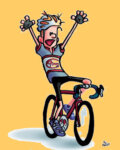riding in sandals
Our Community › Forums › General Discussion › riding in sandals
- This topic has 36 replies, 25 voices, and was last updated 11 years, 1 month ago by
PotomacCyclist.
-
CreatorTopic
-
June 9, 2014 at 4:35 pm #915457
 lordofthemarkParticipant
lordofthemarkParticipantMy daughter has taken to riding in sandals – the kind with straps that keep the heel on, not the floppy kind. When my wife posted a pic on facebook, a friend noted the footwear (apparently with concern.) The bike she was riding was our old MTB, and she says her sandals have pretty good traction. Is there really a reason to wear more closed footwear?
-
CreatorTopic
-
AuthorReplies
-
June 9, 2014 at 4:40 pm #1003641
consularrider
ParticipantMy own personal preferance is for having something enclosing the toe, such as the Keen sandals (which come in an spd model even). But then I’m a klutz.
June 9, 2014 at 4:50 pm #1003644TwoWheelsDC
Participant@lordofthemark 87869 wrote:
s there really a reason to wear more closed footwear?
Nope. Beyond personal preference and comfort, I can think of no substantive difference in footwear needs between just riding around (JRA) and just walking around. If the level of effort rises beyond JRA, sturdier shoes may be more comfortable and/or safer, but frankly I think the threshold is fairly high. I’d bike in my flip-flops for 75% of my rides if they were SPD compatible…
June 9, 2014 at 5:05 pm #1003649cyclingfool
ParticipantAgree w/ 2Wheels. I say ride one and don’t worry.
June 9, 2014 at 5:11 pm #1003650sethpo
Participant#teamsandals
[ATTACH=CONFIG]5859[/ATTACH]
June 9, 2014 at 5:18 pm #1003654 ShawnoftheDreadParticipant
ShawnoftheDreadParticipantThe only reason not to is aesthetic. Most people have nasty looking feet that I don’t want to see. Cover your ugly feet, people.
June 9, 2014 at 5:19 pm #1003656 ShawnoftheDreadParticipant
ShawnoftheDreadParticipant@sethpo 87880 wrote:
#teamsandals
[ATTACH=CONFIG]5859[/ATTACH]
Seth is apparently a German tourist. If he shows up at FCC with a fanny pack…
June 9, 2014 at 5:24 pm #1003658Anonymous
GuestI find the risks of riding in sandals to be similar to, but less than, those of walking in sandals. It is possible, but less likely than while walking, to stub your toe accidentally kicking a curb, for example; or to get a small rock in your sandal; probably not possible on a bike to catch the front of the sandal on a crack in the sidewalk causing you to trip and fall…
… what?
June 9, 2014 at 5:36 pm #1003661 chris_sParticipant
chris_sParticipant@sethpo 87880 wrote:
#teamsandals
[ATTACH=CONFIG]5859[/ATTACH]
Are you being attacked by a seething swarm of cheetohs, or is that a really shaggy orange rug?
June 9, 2014 at 5:41 pm #1003662americancyclo
ParticipantJune 9, 2014 at 5:53 pm #1003664Bill Hole
ParticipantA few years back I rented a bike on the big island of Hawaii and went off to visit volcanos. I had no bike shoes and it was too hot for sneakers, so I wore flip-flops. Everything was OK until I flatted and discovered that the spare tube provided with the bike was worthless, and that I was out of cell phone range. I had to push that damn bike three miles back up a mountain until I could call for help. Never, ever, push a bike three miles up a mountain wearing flip-flops! Blisters galore!
June 9, 2014 at 5:56 pm #1003667DismalScientist
ParticipantJune 9, 2014 at 6:11 pm #1003669sethpo
Participant@ShawnoftheDread 87886 wrote:
Seth is apparently a German tourist. If he shows up at FCC with a fanny pack…
FWIW, I picked up the socks and sandals habit while stationed in Germany about 25 years ago (yikes). I don’t, however, wear a fanny pack (anymore). #teamsocksandals
And yes, our office shower room has the only bath mat made entirely from cheetos. You’d think that walking on cheetos with wet feet would be a problem but it is surprisingly supple and durable.
June 9, 2014 at 6:32 pm #1003670 Steve OParticipant
Steve OParticipantSandals are the way to go when it’s raining and relatively warm out (no socks, though, d’uh!). Works great for commuting. Having soggy socks is a drag. With sandals, you just dry your feet off at your destination, put the shoes and socks you packed in your bag on your feet, and you are ready to go. I did this a couple of times this spring when it was in the 50’s even. Wore my rain pants and jacket over my work clothes and my sandals on my feet.
Just this morning I put the cleats on my new SPD compatible sandals and test drove them to the coffee shop. Cool! (pun intended)
June 9, 2014 at 7:24 pm #1003676PotomacCyclist
ParticipantOther than the possibility of stubbing a toe, one concern might be the flexibility of the sole, but only if she rides a lot. I’ve heard of some people developing plantar fasciitis (irritation or inflammation of the fascia on the bottom of the foot) while riding. PF usually affects runners, not cyclists. Whenever I hear or read about this, I ask what type of shoes the person was using. The answer has always been soft-soled, flexible shoes, such as running shoes. I would think there could be a similar issue with sandals if she rides a lot.
[Note that some researchers now believe that PF is actually a set of minor tears in the fascia or foot muscles. I don’t know myself. I’ve heard of people continuing to run through PF, as long as several years, but while having to deal with excruciating pain.]
At the same time, calf tightness and lower leg tightness or weakness is also associated with developing PF. I ride on CaBi bikes a lot (probably the majority of my rides this year and maybe over the past few years as well) in running shoes and other shoes with flexible soles. (Occasionally in Reef sandals.) I’ve never had any problems with PF. I do light stretching after every run and after some tougher bike sessions. I include bent-knee and straight-leg calf stretches, bottom of the foot stretches and shin stretches, along with other stretches. I’m familiar enough with the routine by now that the entire series of stretches only takes me a minute or two, even without rushing. I only hold each stretch for a few seconds. I’m mostly working on the muscle fascia. I don’t care as much about developing extreme flexibility, which actually isn’t good for running. I also focus on strength training in the off-season and occasional maintenance strength workouts during the rest of the year. I try to do lower-body strength exercises in bare feet (unless I’m in a gym where that’s not allowed). Doing that helps to strengthen all of the various small muscles in the feet.
When people say that they have tight muscles somewhere, the real issue is often muscle imbalances or weakness. If one muscle is weak, an opposing or interacting muscle can pull on it, causing muscle aches or tightness. If the imbalance isn’t fixed, then an injury can occur. A common case is “tight shoulders” or more accurately tight trapezius or upper back. This usually results from weak lat muscles, which most people rarely use unless they workout regularly. They also sit at desks and use computers often. Weak lats and too much sitting causes the traps to get very tight and sore. Stretching provides a temporary fix, but the muscle imbalances need to be fixed for a true fix. (I had a severe case of muscle imbalances more than a decade ago, when I was very inactive and weak. Long story, but the summary is that an activity, piano playing for rehearsals, caused my traps to get very tight while my lats were weak from lack of use. After a month of this, one of the traps ripped when I stood up. Most painful experience of my life.)
PF seems to be easily avoided. And just like with any injury, it’s far better to avoid it than to have to deal with it once it develops. If you visit running forums, you’ll find thread after thread of people asking about dealing with overuse injuries. Mostly because runners tend not to follow certain smart practices: preventative work, not doing too much too soon, treating an injury properly before it develops into a chronic condition or a serious injury. When strength training is mentioned, many of them go on and on about how “Kenyans don’t strength train” and/or they continue to think that strength training is the same as bodybuilding or powerlifting (which it isn’t). Then they continue to develop the same overuse injuries that runners keep developing every year, over and over again. Cyclists tend not to develop as many overuse injuries as runners do, because of the lower impact of cycling. But plantar fasciitis is one issue that I’ve read complaints about several times, nearly always with people who do a fair amount of riding/training in flexible running shoes.
PF is not considered a serious injury, but it can be very painful. It can also be very difficult to treat once it develops, because of the difficulty of resting the foot muscles and fascia. Prevention is far better than trying to cure it.
So I’d say, for short, infrequent, low-intensity rides, sandals probably won’t be an issue. For longer, more frequent and higher-intensity rides, the flexible soles could become a problem, especially if she also has tightness in the calves and Achilles, or other tightness/weakness issues in the calves, shins and feet or muscle imbalances in the lower legs. Bike-specific sandals, like Keen and Shimano, are other options. Those sandals have hard soles. (I wear Keen sandals sometimes, but I don’t know why they are so heavy. They are heavier than my regular bike shoes. Maybe because they don’t have fancier lightweight materials. But the MTB shoes don’t have carbon fiber and even those are lighter than the Keen sandals.)
June 9, 2014 at 8:51 pm #1003686Drewdane
Participant@lordofthemark 87869 wrote:
My daughter has taken to riding in sandals – the kind with straps that keep the heel on, not the floppy kind. When my wife posted a pic on facebook, a friend noted the footwear (apparently with concern.) The bike she was riding was our old MTB, and she says her sandals have pretty good traction. Is there really a reason to wear more closed footwear?
-
AuthorReplies
- You must be logged in to reply to this topic.